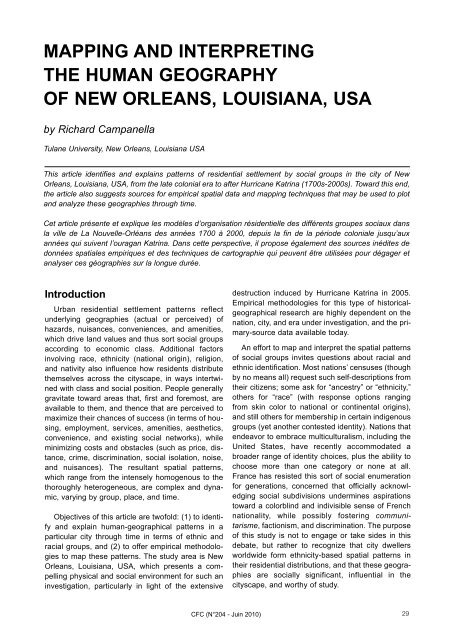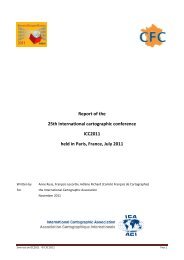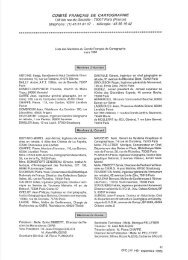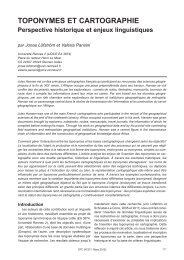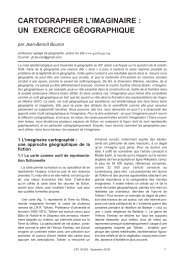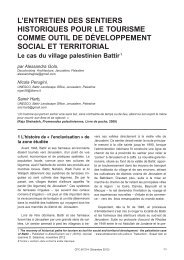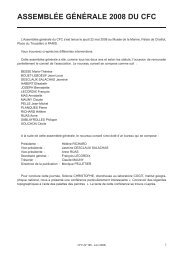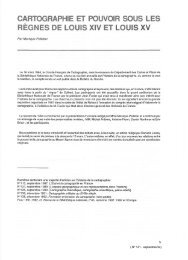mapping and interpreting the human geography of new orleans ...
mapping and interpreting the human geography of new orleans ...
mapping and interpreting the human geography of new orleans ...
You also want an ePaper? Increase the reach of your titles
YUMPU automatically turns print PDFs into web optimized ePapers that Google loves.
MAPPING AND INTERPRETING<br />
THE HUMAN GEOGRAPHY<br />
OF NEW ORLEANS, LOUISIANA, USA<br />
by Richard Campanella<br />
Tulane University, New Orleans, Louisiana USA<br />
This article identifies <strong>and</strong> explains patterns <strong>of</strong> residential settlement by social groups in <strong>the</strong> city <strong>of</strong> New<br />
Orleans, Louisiana, USA, from <strong>the</strong> late colonial era to after Hurricane Katrina (1700s-2000s). Toward this end,<br />
<strong>the</strong> article also suggests sources for empirical spatial data <strong>and</strong> <strong>mapping</strong> techniques that may be used to plot<br />
<strong>and</strong> analyze <strong>the</strong>se geographies through time.<br />
Cet article présente et explique les modèles d’organisation résidentielle des différents groupes sociaux dans<br />
la ville de La Nouvelle-Orléans des années 1700 à 2000, depuis la fin de la période coloniale jusqu’aux<br />
années qui suivent l’ouragan Katrina. Dans cette perspective, il propose également des sources inédites de<br />
données spatiales empiriques et des techniques de cartographie qui peuvent être utilisées pour dégager et<br />
analyser ces géographies sur la longue durée.<br />
Introduction<br />
Urban residential settlement patterns reflect<br />
underlying geographies (actual or perceived) <strong>of</strong><br />
hazards, nuisances, conveniences, <strong>and</strong> amenities,<br />
which drive l<strong>and</strong> values <strong>and</strong> thus sort social groups<br />
according to economic class. Additional factors<br />
involving race, ethnicity (national origin), religion,<br />
<strong>and</strong> nativity also influence how residents distribute<br />
<strong>the</strong>mselves across <strong>the</strong> cityscape, in ways intertwined<br />
with class <strong>and</strong> social position. People generally<br />
gravitate toward areas that, first <strong>and</strong> foremost, are<br />
available to <strong>the</strong>m, <strong>and</strong> <strong>the</strong>nce that are perceived to<br />
maximize <strong>the</strong>ir chances <strong>of</strong> success (in terms <strong>of</strong> housing,<br />
employment, services, amenities, aes<strong>the</strong>tics,<br />
convenience, <strong>and</strong> existing social networks), while<br />
minimizing costs <strong>and</strong> obstacles (such as price, distance,<br />
crime, discrimination, social isolation, noise,<br />
<strong>and</strong> nuisances). The resultant spatial patterns,<br />
which range from <strong>the</strong> intensely homogenous to <strong>the</strong><br />
thoroughly heterogeneous, are complex <strong>and</strong> dynamic,<br />
varying by group, place, <strong>and</strong> time.<br />
Objectives <strong>of</strong> this article are tw<strong>of</strong>old: (1) to identify<br />
<strong>and</strong> explain <strong>human</strong>-geographical patterns in a<br />
particular city through time in terms <strong>of</strong> ethnic <strong>and</strong><br />
racial groups, <strong>and</strong> (2) to <strong>of</strong>fer empirical methodologies<br />
to map <strong>the</strong>se patterns. The study area is New<br />
Orleans, Louisiana, USA, which presents a compelling<br />
physical <strong>and</strong> social environment for such an<br />
investigation, particularly in light <strong>of</strong> <strong>the</strong> extensive<br />
destruction induced by Hurricane Katrina in 2005.<br />
Empirical methodologies for this type <strong>of</strong> historicalgeographical<br />
research are highly dependent on <strong>the</strong><br />
nation, city, <strong>and</strong> era under investigation, <strong>and</strong> <strong>the</strong> primary-source<br />
data available today.<br />
An effort to map <strong>and</strong> interpret <strong>the</strong> spatial patterns<br />
<strong>of</strong> social groups invites questions about racial <strong>and</strong><br />
ethnic identification. Most nations’ censuses (though<br />
by no means all) request such self-descriptions from<br />
<strong>the</strong>ir citizens; some ask for “ancestry” or “ethnicity,”<br />
o<strong>the</strong>rs for “race” (with response options ranging<br />
from skin color to national or continental origins),<br />
<strong>and</strong> still o<strong>the</strong>rs for membership in certain indigenous<br />
groups (yet ano<strong>the</strong>r contested identity). Nations that<br />
endeavor to embrace multiculturalism, including <strong>the</strong><br />
United States, have recently accommodated a<br />
broader range <strong>of</strong> identity choices, plus <strong>the</strong> ability to<br />
choose more than one category or none at all.<br />
France has resisted this sort <strong>of</strong> social enumeration<br />
for generations, concerned that <strong>of</strong>ficially acknowledging<br />
social subdivisions undermines aspirations<br />
toward a colorblind <strong>and</strong> indivisible sense <strong>of</strong> French<br />
nationality, while possibly fostering communitarisme,<br />
factionism, <strong>and</strong> discrimination. The purpose<br />
<strong>of</strong> this study is not to engage or take sides in this<br />
debate, but ra<strong>the</strong>r to recognize that city dwellers<br />
worldwide form ethnicity-based spatial patterns in<br />
<strong>the</strong>ir residential distributions, <strong>and</strong> that <strong>the</strong>se geographies<br />
are socially significant, influential in <strong>the</strong><br />
cityscape, <strong>and</strong> worthy <strong>of</strong> study.<br />
CFC (N°204 - Juin 2010)<br />
29
Ethnic Geography <strong>of</strong> Colonial New<br />
Orleans (1718-1803)<br />
The isolated port <strong>of</strong> Nouvelle Orleans, founded in<br />
1718 on a dynamic river-dominated delta built by <strong>the</strong><br />
channel-shifting <strong>and</strong> flooding cycles <strong>of</strong> <strong>the</strong> Mississippi<br />
River, struggled with incessant natural disaster <strong>and</strong> low<br />
prioritization by French <strong>and</strong> Spanish administrations<br />
for its first eighty years (fig. 1-2). The ethnic <strong>geography</strong><br />
<strong>of</strong> <strong>the</strong> city, whose population never exceeded 8000<br />
throughout <strong>the</strong> entire colonial era (1718-1803), constituted<br />
intermixed spatial patterns <strong>of</strong> a few core groups.<br />
Locally born Francophones (some white <strong>and</strong> originally<br />
from French Canada, <strong>the</strong> French West Indies, or<br />
France itself; some <strong>of</strong> mixed ancestry <strong>and</strong> ei<strong>the</strong>r free or<br />
enslaved; o<strong>the</strong>rs <strong>of</strong> pure African ancestry <strong>and</strong><br />
enslaved) predominated in patterns <strong>of</strong> high spatial<br />
intermixing with members <strong>of</strong> <strong>the</strong> Spanish-speaking<br />
world <strong>and</strong> a small numbers <strong>of</strong> immigrants from elsewhere.<br />
The enslaved population lived in close proximity<br />
to <strong>the</strong>ir masters, <strong>of</strong>ten in adjacent quarters. Detailed<br />
primary-source data fur<strong>the</strong>r articulating <strong>the</strong>se colonialera<br />
geographies are extremely scarce <strong>and</strong> sporadic.<br />
Events during <strong>the</strong> 1790s-1800s transformed New<br />
Orleans from an orphaned outpost <strong>of</strong> two distracted<br />
European powers to a strategically sited port city <strong>of</strong> an<br />
ascendant New World nation. The development <strong>of</strong> <strong>the</strong><br />
“cotton engine” in 1793 <strong>and</strong> <strong>the</strong> successful granulation<br />
<strong>of</strong> Louisiana sugar in 1795 facilitated <strong>the</strong> rapid conversion<br />
<strong>of</strong> New Orleans’ hinterl<strong>and</strong> to plantations <strong>of</strong> highvalue<br />
exportable cotton <strong>and</strong> sugarcane. New Orleans<br />
would benefit tremendously as a marketplace <strong>and</strong><br />
transshipment port for both commodities. The agricultural<br />
technologies also brea<strong>the</strong>d <strong>new</strong> life into <strong>the</strong> institution<br />
<strong>of</strong> slavery, as a labor source in <strong>the</strong> suddenly<br />
lucrative regional plantation economy; New Orleans<br />
would soon become <strong>the</strong> busiest slave market in <strong>the</strong><br />
South. Finally, <strong>the</strong> slave insurgency in St-Domingue,<br />
which began in 1791 <strong>and</strong> eventually expelled <strong>the</strong><br />
French regime, diminished Napoleon’s interest in <strong>the</strong><br />
seemingly unpromising Louisiana colony <strong>and</strong> eventually<br />
motivated him to sell it to <strong>the</strong> United States in 1803.<br />
The events in St-Domingue also decreased <strong>the</strong> supply<br />
<strong>of</strong> West Indian sugar <strong>and</strong> increased dem<strong>and</strong> for<br />
Louisiana cane just as many sugar-savvy Haitians<br />
arrived to New Orleans <strong>and</strong> helped launch a local<br />
sugar industry. Now under U.S. dominion, New<br />
Orleans was poised to boom. Prominent observers<br />
routinely predicted that this <strong>new</strong> American city would,<br />
as one put it, “doubtless one day become <strong>the</strong> greatest<br />
[on <strong>the</strong>] continent, perhaps even in <strong>the</strong> world” (Murray<br />
1829, p. 426). Ano<strong>the</strong>r foresaw New Orleans becoming<br />
“one <strong>of</strong> <strong>the</strong> greatest commercial cities in <strong>the</strong> universe”<br />
(Blowe 1820, p. 64-65).<br />
Ethnic Geography <strong>of</strong> Antebellum<br />
New Orleans (1803-1861)<br />
With limited immigration immediately after<br />
Americanization, <strong>the</strong> ethnic <strong>geography</strong> <strong>of</strong> New<br />
Orleans remained relatively simple. Locally born<br />
French-speaking Catholics (Creoles)—some white,<br />
some <strong>of</strong> mixed ancestry <strong>and</strong> ei<strong>the</strong>r free or enslaved,<br />
o<strong>the</strong>rs <strong>of</strong> pure African ancestry <strong>and</strong> mostly<br />
enslaved—predominated in patterns <strong>of</strong> high spatial<br />
intermixing. Enslaved people continued to reside in<br />
close proximity to <strong>the</strong>ir masters, in adjacent quarters<br />
or nearby common-wall housing. The few Anglo-<br />
American or foreign-born residents generally dispersed<br />
within <strong>the</strong> community <strong>and</strong> numbered too few<br />
to form significant ethnic clusters. In 1809, over 9,000<br />
refugees (roughly evenly divided among white,<br />
enslaved black, <strong>and</strong> free people <strong>of</strong> color) from Haiti<br />
doubled New Orleans’ population, revived its<br />
Francophone <strong>and</strong> Afro-Caribbean culture, <strong>and</strong> reinforced<br />
its ethnically intermixed settlement patterns.<br />
New patterns formed when Anglo-American emigration<br />
increased in <strong>the</strong> 1810s. Arrivals from <strong>the</strong><br />
North <strong>and</strong> nor<strong>the</strong>rn South, seeking opportunities in<br />
<strong>the</strong> rapidly developing Mississippi Valley, brought to<br />
<strong>the</strong> Old World-oriented, French-speaking Catholic<br />
city <strong>the</strong> external influences <strong>of</strong> American commerce<br />
<strong>and</strong> culture, <strong>the</strong> English language, Protestant sects,<br />
<strong>and</strong> <strong>new</strong> concepts in everything from jurisprudence to<br />
architecture to race relations. Anglo-Americans gravitated<br />
to <strong>the</strong> uppermost blocks <strong>of</strong> <strong>the</strong> Creole-dominant<br />
original city (today’s French Quarter), or upriver<br />
from it in <strong>the</strong> recently subdivided Faubourg Ste- Marie<br />
(today’s Central Business District). One early indication<br />
<strong>of</strong> <strong>the</strong> uptown settlement preference among<br />
Anglos comes from an 1808 property ownership map,<br />
in which only 8% <strong>of</strong> <strong>the</strong> 1,237 proprietors had Anglosounding<br />
surnames (such as Donaldson, Smith, or<br />
Johnson), but nearly three-quarters <strong>of</strong> <strong>the</strong>m lived in<br />
<strong>the</strong> uppermost blocks <strong>of</strong> <strong>the</strong> o<strong>the</strong>rwise Creole-dominant<br />
original city 1 . By <strong>the</strong> 1830s, Anglo surnames<br />
numerically outnumbered French Creole names<br />
(such as Villere, Dupuy, or Gagnon) in adjacent<br />
Faubourg Ste-Marie, an area whose name now had<br />
become anglicized to “St. Mary” or “<strong>the</strong> American<br />
Quarter” (Tregle 1992, p.154-157, 164). Economic,<br />
religious, political, <strong>and</strong> cultural institutions arose<br />
1 Analysis by author using “Plan de la Ville de la Nouvelle Orléans Avec les noms des proprietaires,” 1808, map, at The<br />
Historic New Orleans Collection. Not all people with French- or Spanish-sounding surnames were necessarily Creole, nor<br />
were all those with Anglo-sounding surnames necessarily Anglo-Americans.<br />
30 CFC (N°204 - Juin 2010)
among <strong>the</strong> uptown Anglo population, fur<strong>the</strong>r reinforcing<br />
<strong>the</strong> pattern. The same surname-interpretation<br />
methodology exercised on <strong>the</strong> 1842 City Directory<br />
reveals <strong>the</strong> expansion <strong>and</strong> persistence <strong>of</strong> <strong>the</strong> pattern:<br />
in <strong>the</strong> upper city, those with Anglo surnames outnumbered<br />
those with French surnames by a 2.8-to-1 ratio;<br />
in <strong>the</strong> lower Creole-dominant city, <strong>the</strong> ratio reversed:<br />
French outnumbered Anglos 3.2-to-1 2 . It should be<br />
noted that surname interpretation as a methodology<br />
is imperfect, as it may confuse French Creoles with<br />
French immigrants, or miscategorize people who<br />
changed <strong>the</strong>ir names or intermarried. Never<strong>the</strong>less,<br />
in many cases, it is simply <strong>the</strong> only method to derive<br />
mappable social data.<br />
Patterns driven by economic class brought complexity<br />
into this general Creole / Anglo downriver/upriver<br />
ethnic <strong>geography</strong>. In pre-industrial cities, prosperous<br />
members <strong>of</strong> charter groups usually resided in <strong>the</strong> inner<br />
city, with domestic servants <strong>and</strong> slaves living in adjacent<br />
quarters, <strong>and</strong> middle- <strong>and</strong> working-class families<br />
residing in a ring <strong>of</strong> adjacent neighborhoods. Indigents,<br />
among <strong>the</strong>m immigrants, tended to settle at <strong>the</strong> city’s<br />
ragged outskirts or waterfronts. The pattern is an<br />
ancient one—“in many medieval cities in Europe, <strong>the</strong><br />
city centres were inhabited by <strong>the</strong> well-to-do, while <strong>the</strong><br />
outer districts were <strong>the</strong> areas for <strong>the</strong> poorer segments<br />
<strong>of</strong> <strong>the</strong> population” (Van Kempen <strong>and</strong> Özüekren 1998,<br />
p. 1631)—<strong>and</strong> it carried over to New World cities. Lack<br />
<strong>of</strong> mechanized conveyances drove <strong>the</strong> pattern: pedestrian-scale<br />
movement made inner-city living a convenient<br />
<strong>and</strong> expensive luxury, which spatially sorted <strong>the</strong><br />
classes <strong>and</strong> castes into certain residential-settlement<br />
patterns.<br />
So too was <strong>the</strong> case in antebellum New Orleans.<br />
Charter groups, mostly comprising <strong>the</strong> upper classes<br />
<strong>of</strong> French Creole (as well as Français de France) <strong>and</strong><br />
Anglo-American society, tended to live in townhouses<br />
in <strong>the</strong> old inner city. Observed Elisée Réclus in 1853,<br />
“The oldest district <strong>of</strong> New Orleans…is still <strong>the</strong> most<br />
elegant <strong>of</strong> <strong>the</strong> city,” where houses had been “mostly<br />
purchased by American capitalists” (Reclus 1855-<br />
2004, p. 50). Encircling <strong>the</strong> highly desirable commercial/residential<br />
inner core was an annulus <strong>of</strong> middle<strong>and</strong><br />
working-class faubourgs. Fur<strong>the</strong>r out, along <strong>the</strong><br />
wharves, canals, backswamp, <strong>and</strong> upper <strong>and</strong> lower<br />
fringes <strong>of</strong> <strong>the</strong> city, lay a periphery <strong>of</strong> muddy, low-density<br />
village-like developments—“shantytowns,” in<br />
some places. Here resided thous<strong>and</strong>s <strong>of</strong> immigrants<br />
<strong>and</strong> o<strong>the</strong>r working-class <strong>and</strong> poor, including manumitted<br />
blacks. During <strong>the</strong> first great wave <strong>of</strong> immigration<br />
to New Orleans (1820s to 1850s, corresponding to<br />
national trends), laborer families mostly from Irel<strong>and</strong><br />
<strong>and</strong> Germany arrived by <strong>the</strong> thous<strong>and</strong>s <strong>and</strong> settled<br />
throughout this semi-rural periphery. They predominated<br />
in <strong>the</strong> riverside upper fringe (upper Faubourg<br />
St. Mary <strong>and</strong> into <strong>the</strong> adjacent city <strong>of</strong> Lafayette), <strong>the</strong><br />
backswamp around <strong>the</strong> turning basins <strong>of</strong> <strong>the</strong> New<br />
Basin <strong>and</strong> Old Basin canals, <strong>and</strong> <strong>the</strong> lower faubourgs<br />
(known as <strong>the</strong> “Poor Third” Municipality).<br />
Mapping nineteenth-century immigration settlement<br />
in American cities is challenged by limitations in<br />
<strong>of</strong>ficial census data. The U.S. Census did not record<br />
birthplace until 1850, making nation-<strong>of</strong>-origin difficult<br />
to ascertain prior to that decennial enumeration. Even<br />
afterwards, mappable addresses were rarely recorded<br />
along each individual’s personal information. At<br />
best, <strong>the</strong> Census compendium volumes aggregated<br />
residents born in various nations (or, prior to unification<br />
in places like Germany <strong>and</strong> Italy, by regions in<br />
those future nations) at <strong>the</strong> ward level, which can<br />
<strong>the</strong>n be mapped by those polygons. If <strong>the</strong> researcher<br />
wishes to identify patterns at a more granular level,<br />
<strong>the</strong>n surname-based sampling strategies using<br />
sources with mappable addresses (such as city directories<br />
or organizational membership lists) <strong>of</strong>fers<br />
ano<strong>the</strong>r option. In <strong>the</strong> case <strong>of</strong> New Orleans’ Irish <strong>and</strong><br />
German immigrant populations, <strong>the</strong> author used surname<br />
identification (names such as Kelly or those<br />
with Mc-, Mac-, or O’-) to map probable Irish families,<br />
<strong>and</strong> institutional locations (German Protestant,<br />
Catholic, <strong>and</strong> Jewish houses <strong>of</strong> worship) to map<br />
German immigrant settlement. There is also an abundance<br />
<strong>of</strong> qualitative evidence for such patterns, left<br />
behind by visitors, journalists, diarists, <strong>and</strong> o<strong>the</strong>r firstperson<br />
observers.<br />
Antebellum immigrants generally avoided <strong>the</strong> inner<br />
city <strong>and</strong> settled in <strong>the</strong> semi-rural periphery, but rarely<br />
were <strong>the</strong>y wholly absent or intensely clustered in any<br />
particular area. Intermixing predominated: <strong>the</strong> socalled<br />
“Irish Channel” was home to many Germans<br />
<strong>and</strong> o<strong>the</strong>r groups, just as Little Saxony near <strong>the</strong><br />
lower-city riverfront housed as many Irish <strong>and</strong><br />
Creoles as it did Saxons. The main reasons behind<br />
this spatial pattern in immigrant settlement involved<br />
jobs <strong>and</strong> real estate. Low-skill employment in this<br />
era—dock work, flatboat wharf jobs, warehousing,<br />
stockyard <strong>and</strong> tannery work, rope walks, public-works<br />
projects, canal excavation, railroad construction—lay<br />
scattered throughout <strong>the</strong> outer fringe, ra<strong>the</strong>r than<br />
among <strong>the</strong> <strong>of</strong>fices <strong>and</strong> shops <strong>of</strong> <strong>the</strong> exclusive inner<br />
core. Slaves once were assigned <strong>the</strong>se grueling <strong>and</strong><br />
dangerous hard-labor tasks, but because <strong>the</strong>y yielded<br />
higher pr<strong>of</strong>it on sugar plantations, a niche opened<br />
for poor unskilled immigrants. Between <strong>the</strong> 1830s<br />
2 Analysis by author based on New Orleans City Directory <strong>of</strong> 1842<br />
CFC (N°204 - Juin 2010)<br />
31
<strong>and</strong> 1840s, white immigrants mostly from Irel<strong>and</strong> <strong>and</strong><br />
Germany took most <strong>of</strong> <strong>the</strong> unskilled labor, dock worker,<br />
drayman, cabman, domestic, <strong>and</strong> hotel servant<br />
jobs from blacks (both free <strong>and</strong> enslaved). While some<br />
<strong>of</strong> <strong>the</strong> better working-class jobs existed downtown,<br />
most were on <strong>the</strong> outskirts. Also located in that area<br />
was cheap, low-density, cottage-scale housing, which<br />
had open lots for “truck farming,” a favorite extraincome<br />
activity particularly among Germans.<br />
Immigrants <strong>of</strong> <strong>the</strong> antebellum era thus avoided <strong>the</strong><br />
inner city for its lack <strong>of</strong> unskilled-labor employment, its<br />
high real estate prices <strong>and</strong> crowding, <strong>and</strong> because<br />
mechanized transportation (early horse-drawn streetcars)<br />
for commuting was limited <strong>and</strong> costly. Better-<strong>of</strong>f<br />
Irish <strong>and</strong> Germans, who likely arrived earlier (such as<br />
<strong>the</strong> “lace-curtain” Irish establishment <strong>of</strong> <strong>the</strong> Julia Street<br />
area), worked in downtown-based pr<strong>of</strong>essions <strong>and</strong><br />
lived in costly downtown dwellings; <strong>the</strong>y generally<br />
blended in with charter groups <strong>and</strong> rarely rubbed<br />
shoulders with <strong>the</strong>ir poorer, recently arrived brethren.<br />
People born in France comprised <strong>the</strong> third-largest<br />
immigrant group in antebellum New Orleans, followed<br />
by smaller numbers from a wide range <strong>of</strong> sou<strong>the</strong>rn<br />
European <strong>and</strong> Latin l<strong>and</strong>s, such as Spain, present-day<br />
Italy, Cuba, Mexico, Haiti, <strong>the</strong> West Indies, <strong>and</strong> Central<br />
<strong>and</strong> South America. These Catholic peoples <strong>of</strong> <strong>the</strong><br />
Latin world usually settled in <strong>the</strong> working-class neighborhoods<br />
on <strong>the</strong> Creole (lower) side <strong>of</strong> New Orleans,<br />
below <strong>the</strong> French Quarter. With <strong>the</strong> exception <strong>of</strong> some<br />
“foreign French,” Catholic immigrants <strong>of</strong> Latin backgrounds<br />
were uncommon in predominantly Anglo-culture<br />
uptown.<br />
The antebellum <strong>geography</strong> <strong>of</strong> New Orleanians <strong>of</strong><br />
African ancestry consisted <strong>of</strong> enslaved blacks intricately<br />
intermixed with <strong>the</strong> white population (working mostly<br />
as domestics or “hired out” for municipal tasks), while<br />
free people <strong>of</strong> color predominated in <strong>the</strong> lower half <strong>of</strong><br />
<strong>the</strong> city. Anecdotal evidence <strong>of</strong> <strong>the</strong>se patterns comes<br />
from an 1843 article in <strong>the</strong> Daily Picayune: “The<br />
Negroes are scattered through <strong>the</strong> city promiscuously;<br />
those <strong>of</strong> mixed blood, such as Griffes, Quarteroons,<br />
&c., [Creoles <strong>of</strong> color] showing a preference for <strong>the</strong><br />
back streets <strong>of</strong> <strong>the</strong> First [French Quarter, Faubourg<br />
Tremé] <strong>and</strong> part <strong>of</strong> <strong>the</strong> Third Municipality [Faubourg<br />
Marigny <strong>and</strong> adjacent areas]” (Daily Picayune 1843, p.<br />
2, col. 3). The nature <strong>of</strong> urban slavery drove this pattern:<br />
<strong>the</strong> enslaved were kept in close quarters by <strong>the</strong>ir<br />
enslavers for reasons <strong>of</strong> convenience <strong>and</strong> security.<br />
Succession from <strong>the</strong> union (1861), followed by four<br />
years <strong>of</strong> civil war, <strong>the</strong> defeat <strong>of</strong> <strong>the</strong> Confederacy<br />
(1865), <strong>and</strong> <strong>the</strong> emancipation <strong>of</strong> slaves, altered New<br />
Orleans’ destiny in every way imaginable. It also transformed<br />
<strong>the</strong> city’s <strong>human</strong> <strong>geography</strong>.<br />
Postbellum Human Geographies<br />
The millions <strong>of</strong> sou<strong>the</strong>rn <strong>and</strong> eastern Europeans<br />
who arrived to <strong>the</strong> United States (<strong>and</strong> <strong>the</strong> thous<strong>and</strong>s<br />
who came to New Orleans) during <strong>the</strong> second great<br />
wave <strong>of</strong> immigration, 1880s to 1920s, encountered a<br />
rapidly changing urban l<strong>and</strong>scape. Industrialization,<br />
<strong>the</strong> installation <strong>of</strong> urban streetcar networks, <strong>and</strong> <strong>the</strong><br />
rise <strong>of</strong> centralized, high-rise business districts triggered<br />
two important repercussions.<br />
First, in New Orleans, <strong>the</strong> gentry moved out <strong>of</strong> <strong>the</strong><br />
inner city <strong>and</strong> resettled in <strong>new</strong>ly developing “garden<br />
suburbs” along St. Charles Avenue <strong>and</strong> Esplanade<br />
Avenue. In some cases, wealthy families departed<br />
<strong>the</strong>ir opulent townhouses because <strong>the</strong>y lost <strong>the</strong>ir fortunes<br />
to <strong>the</strong> Civil War or struggled economically in its<br />
aftermath; in o<strong>the</strong>r cases, <strong>the</strong>y simply moved away<br />
from <strong>new</strong> urban nuisances <strong>and</strong> toward <strong>new</strong> amenities.<br />
Unsightly <strong>and</strong> smelly breweries, warehouses,<br />
<strong>and</strong> sugar refineries arose in <strong>the</strong> French Quarter in<br />
this era, a block or two from once-elegant mansions.<br />
Faubourg St. Mary began to look less like a faubourg<br />
<strong>and</strong> more like a congested downtown. Inner-city living<br />
lost its appeal. With convenient <strong>new</strong> streetcar lines<br />
affording rapid access to pr<strong>of</strong>essional jobs in downtown<br />
<strong>of</strong>fices, people no longer had to prioritize for<br />
pedestrian access in choosing where to live. This<br />
exodus, which can be traced to <strong>the</strong> 1830s-1850s but<br />
was mostly a postbellum trend, opened up scores <strong>of</strong><br />
spacious inner-city townhouses as potential apartment<br />
housing for working-class folk. As recently as<br />
1939, fully 78% <strong>of</strong> <strong>the</strong> city’s antebellum-era dwelling<br />
units were occupied by tenants ra<strong>the</strong>r than owners,<br />
<strong>and</strong> most <strong>of</strong> <strong>the</strong>se units were located in or near <strong>the</strong><br />
inner city 3 .<br />
Second, employment for <strong>the</strong> unskilled poor moved<br />
from <strong>the</strong> semi-rural periphery, where <strong>the</strong>y existed in<br />
<strong>the</strong> agrarian days before <strong>the</strong> Civil War, to <strong>the</strong> urban<br />
core, where postbellum modernization created <strong>new</strong><br />
opportunities. Labor-intensive jobs disappeared from<br />
<strong>the</strong> periphery because those very l<strong>and</strong>s were being<br />
developed into <strong>the</strong> garden suburbs for <strong>the</strong> relocating<br />
upper class, <strong>and</strong> because much <strong>of</strong> <strong>the</strong> needed infrastructure<br />
(canals, railroads) was already in place.<br />
Whereas an 1830s Irish laborer might have been<br />
drawn to <strong>the</strong> backswamp to dig a canal, or an 1840s<br />
German worker to <strong>the</strong> Lafayette wharves to unload<br />
flatboats, a Sicilian, Russian, Polish, or Chinese<br />
immigrant in <strong>the</strong> 1890s gravitated downtown to mar-<br />
3 In 1939, <strong>the</strong>re were 5,941 dwelling units within <strong>the</strong> 2,204 surviving pre-1860 buildings, <strong>of</strong> which 4,605 were rented to<br />
tenants (Carter 1941, p.36 <strong>and</strong> 52).<br />
32 CFC (N°204 - Juin 2010)
ket housewares, peddle fruit, prepare food, or sell<br />
notions. Newly arrived immigrants not only had a reason<br />
to settle close to downtown, but an affordable<br />
apartment to rent <strong>the</strong>re as well.<br />
Thus, unlike <strong>the</strong>ir antebellum predecessors, immigrants<br />
<strong>of</strong> <strong>the</strong> late nineteenth century eschewed <strong>the</strong><br />
semi-rural periphery, favoring instead to live in a concentric<br />
zone <strong>of</strong> neighborhoods immediately beyond<br />
<strong>the</strong> inner commercial core. This “immigrant belt”<br />
<strong>of</strong>fered enough advantages (proximity to work, convenience,<br />
housing) to make life easier for impoverished<br />
<strong>new</strong>comers, but suffered enough nuisances<br />
(crowded conditions, decaying old building, noise,<br />
vice, crime) to keep <strong>the</strong> rent affordable. It <strong>of</strong>fered to<br />
poor immigrants a place to work, a nearby <strong>and</strong> affordable<br />
abode in which to live, <strong>and</strong> (after an enclave<br />
developed) a social support haven including religious<br />
<strong>and</strong> cultural institutions. The immigrant belt ran loosely<br />
from <strong>the</strong> lower French Quarter <strong>and</strong> Faubourg<br />
Marigny/Bywater, through <strong>the</strong> Faubourg Tremé <strong>and</strong><br />
into <strong>the</strong> Third Ward back-<strong>of</strong>-town, around <strong>the</strong> Dryades<br />
Street area, through <strong>the</strong> Lee Circle area <strong>and</strong> toward<br />
<strong>the</strong> riverfront in what is now called <strong>the</strong> Irish Channel.<br />
In this amorphous swath, immigrants <strong>and</strong> <strong>the</strong>ir<br />
descendents clustered well into <strong>the</strong> twentieth century,<br />
such that <strong>the</strong>ir enclaves earned popular monikers<br />
(“Little Palermo,” “Chinatown”) or strong people-place<br />
associations, such as “<strong>the</strong> Orthodox Jews <strong>of</strong> Dryades<br />
Street” or “<strong>the</strong> Greeks <strong>of</strong> North Dorgenois Street”.<br />
Although ethnic groups clustered more intensely in<br />
<strong>the</strong> postbellum immigrant belt than in <strong>the</strong> antebellum<br />
semi-rural periphery, ethnic intermixing still predominated.<br />
With <strong>the</strong> exception <strong>of</strong> certain black back-<strong>of</strong>town<br />
areas, rare was <strong>the</strong> block or neighborhood in<br />
which only one group could be found. Page after<br />
page <strong>of</strong> census population schedules record Sicilians<br />
living next to African-Americans, Irish sharing a double<br />
with Greeks, Filipinos living across <strong>the</strong> street from<br />
Mexicans—even in enclaves in which a particular<br />
group numerically predominated. Ethnic intermixture<br />
is an integral childhood memory <strong>of</strong> most New<br />
Orleanians who came <strong>of</strong> age prior to <strong>the</strong> 1960s, <strong>and</strong><br />
it is striking how <strong>of</strong>ten this observation arises in <strong>the</strong>ir<br />
reminiscences.<br />
The postbellum era also saw <strong>the</strong> migration <strong>of</strong> thous<strong>and</strong>s<br />
<strong>of</strong> emancipated slaves into <strong>the</strong> city from nearby<br />
plantations. Their settlement patterns were driven<br />
in large part by <strong>the</strong> <strong>geography</strong> <strong>of</strong> environmental hazards<br />
<strong>and</strong> nuisances, coupled with <strong>the</strong> disdain <strong>and</strong> discrimination<br />
<strong>the</strong>y suffered in an unwelcoming society.<br />
Flooding, mosquitoes, swamp miasmas, noisy railroads,<br />
smelly wharves <strong>and</strong> canals, industries, pollution,<br />
odd-shaped lots, lack <strong>of</strong> city services, inconvenience:<br />
<strong>the</strong>se <strong>and</strong> o<strong>the</strong>r objectionable circumstances<br />
drove down real estate prices <strong>and</strong> thus formed <strong>the</strong><br />
l<strong>and</strong>s <strong>of</strong> last resort for those at <strong>the</strong> bottom rung. The<br />
natural <strong>and</strong> built environment <strong>of</strong> New Orleans dictated<br />
that most nuisances <strong>and</strong> monopolized <strong>the</strong> city’s<br />
two lateral fringes: <strong>the</strong> immediate riverfront <strong>and</strong> <strong>the</strong><br />
backswamp. Poor African-Americans, <strong>the</strong> majority <strong>of</strong><br />
who were culturally Anglo ra<strong>the</strong>r than Creole, clustered<br />
in <strong>the</strong>se troubled areas, particularly <strong>the</strong> back-<strong>of</strong>town,<br />
while o<strong>the</strong>rs settled within walking distance <strong>of</strong><br />
<strong>the</strong>ir domestic employment jobs in uptown mansions.<br />
Creoles, particularly those <strong>of</strong> color, remained in <strong>the</strong>ir<br />
historical lower-city location, <strong>and</strong> migrated lakeward<br />
as drainage technology opened up <strong>the</strong> backswamps<br />
<strong>of</strong> <strong>the</strong> Seventh Ward <strong>and</strong> adjacent areas. O<strong>the</strong>r sections<br />
<strong>of</strong> <strong>the</strong> <strong>new</strong> lakefront subdivisions laid out in <strong>the</strong><br />
early twentieth century explicitly excluded black residency<br />
through racist deed covenants. By that time,<br />
wealthier whites resided in <strong>the</strong> convenient, low-nuisance<br />
swath s<strong>and</strong>wiched between <strong>the</strong> riverfront <strong>and</strong><br />
<strong>the</strong> backswamp (particularly along <strong>the</strong> St.<br />
Charles/Magazine corridor), <strong>and</strong> in <strong>the</strong> <strong>new</strong> lakeside<br />
neighborhoods, while working-class whites intermixed<br />
throughout <strong>the</strong> front-<strong>of</strong>-town.<br />
New Orleans prides itself on its uniqueness, sometimes<br />
to <strong>the</strong> point <strong>of</strong> extolling peculiarities where none<br />
exists. In fact, <strong>the</strong> Crescent City’s ethnic distributions<br />
mimic those <strong>of</strong> o<strong>the</strong>r American cities. The expression<br />
<strong>of</strong> immigrant enclaves, wrote one social geographer,<br />
commonly “takes <strong>the</strong> form <strong>of</strong> a concentric zone <strong>of</strong> ethnic<br />
neighbourhoods which has spread from an initial<br />
cluster to encircle <strong>the</strong> CBD” (Knox 1987, p. 256) —<br />
very much what occurred in New Orleans. In Cities<br />
<strong>and</strong> Immigrants: A Geography <strong>of</strong> Change in<br />
Nineteenth Century America, David Ward stated that<br />
researchers are “generally able to agree that most<br />
immigrants congregated on <strong>the</strong> edge <strong>of</strong> <strong>the</strong> central<br />
business district, which provided <strong>the</strong> largest <strong>and</strong> most<br />
diverse source <strong>of</strong> unskilled employment” (Ward 1971,<br />
p.106). The concentric-ring phenomenon is st<strong>and</strong>ard<br />
material in urban-<strong>geography</strong> literature, where it<br />
appears diagrammatically as Ernest W. Burgess’<br />
classic “Concentric Zone Model,” part <strong>of</strong> <strong>the</strong> so-called<br />
Chicago School <strong>of</strong> Urban Sociology. According to<br />
Burgess’ model, a <strong>the</strong>oretical city’s central business<br />
district was surrounded first by a “zone in transition,”<br />
<strong>the</strong>n a “zone <strong>of</strong> workingmen’s homes,” a “residential<br />
zone,” <strong>and</strong> finally a “commuters’ zone.” In that transitional<br />
zone could be found “deteriorating…roominghouse<br />
districts” <strong>and</strong> “slums,” populated by “immigrant<br />
colonies” such as “Little Sicily, Greektown,<br />
Chinatown—fascinatingly combining old world heritages<br />
<strong>and</strong> American adaptations.” “Near by is <strong>the</strong><br />
Latin Quarter,” Burgess added, “where creative <strong>and</strong><br />
rebellious spirits resort.” In <strong>the</strong> “zone <strong>of</strong> workingmen’s<br />
CFC (N°204 - Juin 2010)<br />
33
homes,” Burgess predicted Germans, German Jews,<br />
<strong>and</strong> o<strong>the</strong>r second-generation immigrants to settle,<br />
<strong>and</strong> in <strong>the</strong> residential <strong>and</strong> commuter zones, he foresaw<br />
restricted residential districts <strong>and</strong> bungalow suburbs.<br />
Burgess had Chicago in mind when he devised<br />
his Concentric Zone Model, but to a remarkable<br />
degree, he could have been describing circa-1900<br />
New Orleans. Little Palermo, Chinatown, <strong>the</strong> Greek<br />
area, <strong>and</strong> <strong>the</strong> Orthodox Jewish neighborhood all fell<br />
within Burgess’ transitional zone (which we are calling<br />
<strong>the</strong> “immigrant belt” in this paper). Germans,<br />
German Jews, Irish, <strong>and</strong> o<strong>the</strong>r earlier immigrants <strong>and</strong><br />
<strong>the</strong>ir descendents settled in <strong>the</strong> workingmen’s zone<br />
(former Lafayette, <strong>the</strong> Third District, <strong>and</strong> o<strong>the</strong>r areas<br />
<strong>of</strong> <strong>the</strong> old semi-rural periphery). Burgess’ restricted<br />
residential zone <strong>and</strong> commuter zones describe <strong>the</strong><br />
leafy garden suburbs (also known as “trolley” or<br />
“streetcar suburbs,” for <strong>the</strong> developmental role played<br />
by that conveyance) <strong>of</strong> uptown, Esplanade Avenue,<br />
Lakeview, <strong>and</strong> Gentilly—right down to <strong>the</strong> bungalows.<br />
Even his Latin Quarter model found local representation:<br />
“creative <strong>and</strong> rebellious spirits” have long gravitated<br />
to <strong>the</strong> French Quarter (Burgess 1925, p. 47-62).<br />
Twentieth-Century<br />
Ethnic Geographies (fig. 3-4)<br />
Between 1893 <strong>and</strong> 1915, New Orleans installed a<br />
technologically advanced urban drainage system. The<br />
Progressive Era municipal improvement project, which<br />
collected run<strong>of</strong>f from <strong>the</strong> natural levee <strong>and</strong> pumped it<br />
through manmade drainage canals into adjacent lakes,<br />
had <strong>the</strong> effect <strong>of</strong> “neutralizing” topography as <strong>the</strong> premier<br />
factor restricting urban expansion. Suddenly, <strong>the</strong><br />
nuisances <strong>and</strong> risks long associated with low-lying<br />
l<strong>and</strong>—floods, mosquitoes, muddy streets—disappeared.<br />
At roughly <strong>the</strong> same time, automobiles <strong>and</strong> streetcar<br />
networks largely neutralized geographical distance<br />
as <strong>the</strong> o<strong>the</strong>r factor restricting urban expansion.<br />
Between <strong>the</strong> 1910s <strong>and</strong> 1940s, California-style bungalows,<br />
English cottages, Neoclassical mansions, <strong>and</strong><br />
Spanish Revival villas laid out along neat orthogonal<br />
grids arose in large numbers throughout lakefront New<br />
Orleans. Concerns about hurricane-induced storm<br />
surges were abated when <strong>the</strong> Lakefront Project (1926-<br />
1934) barricaded <strong>the</strong> l<strong>and</strong> from Lake Pontchartrain<br />
with a sea wall <strong>and</strong> green expanse <strong>of</strong> elevated artificial<br />
fill. With explicitly racist deed covenants excluding sale<br />
or rental to black families, <strong>the</strong> white middle class “leapfrogged”<br />
over <strong>the</strong> black back-<strong>of</strong>-town <strong>and</strong> settled into<br />
low-lying <strong>new</strong> suburbs such as Gentilly <strong>and</strong> Lakeview.<br />
Topographic <strong>and</strong> distance neutralization, plus legally<br />
sanctioned racial polarization, were among <strong>the</strong> factors<br />
that disaggregated <strong>the</strong> historically spatially heterogeneous<br />
patterns <strong>of</strong> ethnic New Orleans.<br />
Those trends intensified with post-World War II<br />
social <strong>and</strong> structural changes. New Orleans’ “white<br />
flight” experience resembled those <strong>of</strong> o<strong>the</strong>r American<br />
cities, delayed by a decade or so. Between 1960 <strong>and</strong><br />
<strong>the</strong> 1980s, much <strong>of</strong> <strong>the</strong> white population dispersed for<br />
<strong>the</strong> recently drained suburbs <strong>of</strong> Jefferson, St. Bernard,<br />
<strong>and</strong> eastern Orleans parishes. Reasons for <strong>the</strong> exodus<br />
differed little from o<strong>the</strong>r cities: resistance to school integration,<br />
increasing crime rates, decline <strong>of</strong> public<br />
schools, <strong>and</strong> urban decay on <strong>the</strong> “push” side; good<br />
school districts, safety, suburban lifestyles, less<br />
congestion, <strong>and</strong> a lower cost <strong>of</strong> living on <strong>the</strong> “pull” side.<br />
Resistance to school integration drove many workingclass<br />
white families out <strong>of</strong> <strong>the</strong> former “immigrant belt,”<br />
particularly from <strong>the</strong> working-class Ninth Ward, <strong>and</strong><br />
into adjacent St. Bernard Parish. The Lower Ninth<br />
Ward, which in 1940 was mostly working-class white<br />
by <strong>the</strong> river <strong>and</strong> mostly black in <strong>the</strong> back-<strong>of</strong>-town, became<br />
a few decades later almost entirely black, as whites<br />
moved to St. Bernard <strong>and</strong> were replaced by <strong>new</strong> rural<br />
black families arriving to New Orleans in <strong>the</strong> wake <strong>of</strong><br />
cotton <strong>and</strong> sugar agricultural mechanization.<br />
One <strong>of</strong> <strong>the</strong> strongest factors that disaggregated<br />
New Orleans’ intermixed ethnic <strong>and</strong> racial <strong>geography</strong><br />
began as a progressive program designed to help <strong>the</strong><br />
poor. In <strong>the</strong> late 1930s, <strong>the</strong> Housing Authority <strong>of</strong> New<br />
Orleans (HANO) razed old neighborhoods for <strong>new</strong><br />
subsidized, legally segregated housing projects. Of <strong>the</strong><br />
six original projects, <strong>the</strong> two whites-only developments<br />
were higher in elevation <strong>and</strong> closer to <strong>the</strong> front-<strong>of</strong>-town,<br />
while <strong>the</strong> four blacks-only projects were all in lower-elevation,<br />
back-<strong>of</strong>-town locations (Carter 1941, map following<br />
p. 17). When <strong>the</strong> projects were de-segregated in<br />
<strong>the</strong> 1960s, whites promptly departed for affordableliving<br />
alternatives in working-class suburbs, <strong>and</strong> were<br />
replaced by poor blacks, many <strong>of</strong> <strong>the</strong>m recently arrived<br />
to <strong>the</strong> city from rural areas. Within a few years, tens <strong>of</strong><br />
thous<strong>and</strong>s <strong>of</strong> <strong>the</strong> city’s poorest African-Americans<br />
became intensely consolidated <strong>and</strong> isolated into a<br />
dozen or so Gulag-like subsidized projects. With that<br />
concentrated poverty came myriad social ills, including<br />
fa<strong>the</strong>rless households, teen pregnancy, violent crime,<br />
<strong>and</strong> intergenerational government dependency. “The<br />
Projects” fur<strong>the</strong>red <strong>the</strong> paradoxical de facto segregation<br />
<strong>of</strong> residential settlement patterns <strong>of</strong> black <strong>and</strong><br />
white New Orleanians, even as <strong>the</strong>y integrated in<br />
schools, <strong>of</strong>fices, <strong>and</strong> lunch counters.<br />
Suburban lifestyles beckoned not only to <strong>the</strong> white<br />
middle class but to immigrants. Hispanics, principally<br />
from Central America, <strong>and</strong> Vietnamese war refugees,<br />
first settled into <strong>the</strong> area with <strong>the</strong> guidance <strong>of</strong> <strong>the</strong><br />
Catholic Church, arrived in modest numbers in <strong>the</strong> late<br />
twentieth century. Unlike <strong>the</strong>ir equivalents from a century<br />
earlier, <strong>the</strong>se <strong>new</strong> immigrants tended to settle not<br />
34 CFC (N°204 - Juin 2010)
immediately around <strong>the</strong> inner core but in <strong>the</strong> extreme<br />
suburban fringe <strong>of</strong> <strong>the</strong> metropolis, in suburbs such as<br />
Kenner, in <strong>the</strong> eastern New Orleans subdivision <strong>of</strong><br />
Versailles, <strong>and</strong> throughout <strong>the</strong> suburban West Bank.<br />
Again, New Orleans’ experience echoes national<br />
norms: immigrants across America now settle in large<br />
numbers in suburbia; popular notions <strong>of</strong> immigrantdominated<br />
inner cities <strong>and</strong> homogenous white suburbs<br />
are increasingly obsolete.<br />
Suburban lifestyles also attracted <strong>the</strong> black middle<br />
class. Because this group was historically associated<br />
with <strong>the</strong> downtown-based Creole community, its<br />
expansion into suburban-style subdivisions tended to<br />
occur in <strong>the</strong> drained backswamp adjacent to <strong>the</strong> old<br />
Creole faubourgs. Black, middle-class, mostly Creole<br />
New Orleanians thus spread lakeward in <strong>the</strong> early to<br />
mid-twentieth century almost exclusively on <strong>the</strong><br />
downtown side <strong>of</strong> <strong>the</strong> city, east <strong>of</strong> City Park, <strong>and</strong> most<br />
famously in <strong>the</strong> Seventh Ward 4 . The presence <strong>of</strong> a<br />
robust <strong>and</strong> civically engaged black middle class in<br />
this area attracted o<strong>the</strong>r blacks—both Anglo-African<br />
Americans <strong>and</strong> Franco-African Americans as well as<br />
outsiders—to settle here. When white philanthropists<br />
funded <strong>the</strong> construction <strong>of</strong> <strong>the</strong> first modern post-Word<br />
War II suburban subdivision for blacks (Pontchartrain<br />
Park) in 1955, it was located in <strong>the</strong> lakeside Seabrook<br />
section <strong>of</strong> <strong>the</strong> Ninth Ward, fur<strong>the</strong>ring <strong>the</strong> spread <strong>of</strong><br />
black middle class in <strong>the</strong> area between City Park <strong>and</strong><br />
<strong>the</strong> Industrial Canal. The transformation was met in<br />
<strong>the</strong> 1970s <strong>and</strong> 1980s with <strong>the</strong> departure <strong>of</strong> whites<br />
from <strong>the</strong> early-twentieth century developments along<br />
<strong>the</strong> Gentilly Ridge, availing more space <strong>and</strong> fine<br />
housing stock for middle-class black families. The<br />
same was true for eastern New Orleans, <strong>the</strong> last<br />
major suburban development within Orleans Parish.<br />
Initially mostly white in <strong>the</strong> 1960s <strong>and</strong> 1970s, “New<br />
Orleans East” swiftly transformed to a majority-black<br />
area after <strong>the</strong> decline <strong>of</strong> <strong>the</strong> oil economy in <strong>the</strong> early<br />
1980s <strong>and</strong> <strong>the</strong> concurrent development <strong>of</strong> multi-family<br />
housing, including many subsidized units.<br />
Black residential expansion into <strong>the</strong> abundant<br />
twentieth-century housing stock in <strong>the</strong> eastern half <strong>of</strong><br />
<strong>the</strong> city can be largely traced back to this area’s adjacency<br />
to <strong>the</strong> historical hearth <strong>of</strong> <strong>the</strong> middle-class<br />
black Creole community. The equivalent areas west<br />
<strong>of</strong> City Park—Lakeview <strong>and</strong> adjacent neighborhoods—were<br />
unattached to source regions <strong>of</strong> historical<br />
black settlement areas, particularly middle-class<br />
ones, <strong>and</strong> remained mostly white. New Orleans as a<br />
whole, which was a majority-white city from <strong>the</strong> 1830s<br />
to <strong>the</strong> 1970s, declined in population from a peak <strong>of</strong><br />
627,525 in 1960 to 462,269 in 2004, <strong>of</strong> whom close to<br />
70% were black.<br />
Ethnic Geography <strong>of</strong> Katrina’s<br />
Floodwaters (fig. 5)<br />
After Hurricane Katrina (August 29, 2005) overwhelmed<br />
New Orleans’ under-engineered levee-protection<br />
system <strong>and</strong> inundated vast expanses <strong>of</strong> <strong>the</strong><br />
city for weeks, observers remarked openly about <strong>the</strong><br />
overwhelming preponderance <strong>of</strong> <strong>the</strong> African-<br />
American poor among those str<strong>and</strong>ed within <strong>the</strong> city.<br />
Many journalists explained <strong>the</strong> disproportion among<br />
str<strong>and</strong>ed population as a product <strong>of</strong> historical spatial<br />
correlations between class (<strong>and</strong> by extension race)<br />
<strong>and</strong> topographic elevation (<strong>and</strong> by extension flooding),<br />
i.e., that wealthy whites generally lived in high,<br />
dry areas, <strong>and</strong> poor African-Americans resided in low,<br />
wet areas. Was this <strong>human</strong>-environmental relationship<br />
as linear <strong>and</strong> direct as described? The following<br />
study investigates this question. Using Geographic<br />
Information Systems, <strong>the</strong> extent <strong>of</strong> <strong>the</strong> flood was delineated<br />
as it stood on September 8 5 . That polygon,<br />
representing persistently <strong>and</strong> deeply flooded areas<br />
(ra<strong>the</strong>r than areas that were briefly <strong>and</strong> lightly inundated)<br />
was intersected with block-level racial demographic<br />
data from <strong>the</strong> 2000 Census. Results are presented<br />
for <strong>the</strong> metropolitan area (that is, <strong>the</strong> contiguous<br />
urbanized portions <strong>of</strong> Orleans, Jefferson, <strong>and</strong> St.<br />
Bernard parishes on both banks, excluding rural fringe<br />
regions), <strong>and</strong> for New Orleans (Orleans Parish)<br />
alone.<br />
For <strong>the</strong> metropolitan area, 40% <strong>of</strong> <strong>the</strong> total population<br />
<strong>of</strong> 988,182 resided in areas that were under water<br />
on September 8. Blacks outnumbered whites within<br />
that flooded area by over a 2-to-1 ratio, 257,375 to<br />
121,262, even though whites outnumbered blacks<br />
metropolis-wide, 500,672 to 429,902. People <strong>of</strong> Asian<br />
<strong>and</strong> Hispanic ancestry numbered 9,240 <strong>and</strong> 11,830<br />
among <strong>the</strong> flooded population, <strong>and</strong> 25,552 <strong>and</strong> 49,342<br />
among <strong>the</strong> total population, respectively. Thus, while<br />
one in every four whites’ homes, one in four Hispanics’<br />
homes, <strong>and</strong> one in three Asians’ homes flooded<br />
throughout <strong>the</strong> tri-parish metropolis (24, 24, <strong>and</strong> 36%,<br />
4 The association <strong>of</strong> <strong>the</strong> Seventh Ward with <strong>the</strong> modern-day black Creole community is well-known to New Orleanians,<br />
<strong>and</strong> is substantiated by <strong>mapping</strong> out congregations <strong>of</strong> black Catholics—a reasonable though not perfect indicator <strong>of</strong><br />
Creole heritage—at <strong>the</strong> level <strong>of</strong> church parishes.<br />
5 Flood extent was delineated by <strong>the</strong> author through multispectral satellite imagery plus analyses from National<br />
Oceanographic <strong>and</strong> Atmospheric Administration, Federal Emergency Management Agency, Times-Picayune, <strong>and</strong> o<strong>the</strong>r<br />
sources. All demographic data are derived from 2000 U.S. Census enumerations at <strong>the</strong> block level. The population <strong>of</strong> <strong>the</strong><br />
city had declined by about 4.5% between <strong>the</strong> 2000 census <strong>and</strong> Hurricane Katrina.<br />
CFC (N°204 - Juin 2010)<br />
35
espectively), close to two <strong>of</strong> every three African-<br />
Americans’ homes (60%) were inundated. In sum,<br />
whites made up 51% <strong>of</strong> <strong>the</strong> pre-Katrina metropolitan<br />
population <strong>and</strong> 31% <strong>of</strong> its flood victims; blacks made<br />
up 44% <strong>and</strong> 65%; Asians made up 2.6% <strong>and</strong> 2.3%;<br />
<strong>and</strong> Hispanics made up 5% <strong>and</strong> 3%.<br />
Considering only New Orleans, 61% <strong>of</strong> <strong>the</strong> total<br />
population <strong>of</strong> 480,256 resided in areas that were<br />
flooded on September 8. Blacks outnumbered whites<br />
within that flooded area, by over a 3.8-to-1 ratio<br />
(220,970 to 57,469). Blacks also outnumbered whites<br />
citywide before <strong>the</strong> storm, 2.4-to-1 (323,868 to<br />
134,012). People <strong>of</strong> Asian <strong>and</strong> Hispanic ancestry<br />
numbered 7,753 <strong>and</strong> 7,826 among <strong>the</strong> flooded population,<br />
<strong>and</strong> 10,751 <strong>and</strong> 14,663 citywide, respectively.<br />
Thus, 43% <strong>of</strong> whites, 53% <strong>of</strong> Hispanics, 68% <strong>of</strong><br />
African-Americans, <strong>and</strong> 72% <strong>of</strong> Asians saw <strong>the</strong>ir<br />
homes flood in New Orleans. In sum, African-<br />
Americans made up 67% <strong>of</strong> New Orleans’ pre-Katrina<br />
population <strong>and</strong> 76% <strong>of</strong> its flood victims; whites made<br />
up 28% <strong>and</strong> 20%; Hispanics made up 3% <strong>and</strong> 3%;<br />
<strong>and</strong> Asians made up 2% <strong>and</strong> 3%.<br />
Similarly nuanced statistics come from those killed<br />
by <strong>the</strong> storm: while African-American victims outnumbered<br />
whites by more than double, <strong>the</strong>y comprised<br />
66% <strong>of</strong> <strong>the</strong> storm deaths in New Orleans <strong>and</strong> whites<br />
made up 31%, fairly proportionate to pre-storm relative<br />
populations 6 .<br />
The relationship between race/class <strong>and</strong> flooding/elevation<br />
was <strong>the</strong>refore not particularly linear <strong>and</strong><br />
direct. The reason for <strong>the</strong> nuanced, multi-interpretational<br />
nature <strong>of</strong> <strong>the</strong> residential flooding statistics is <strong>the</strong><br />
complex historical ethnic <strong>geography</strong> <strong>of</strong> New Orleans.<br />
Those reports which erroneously implied a strong<br />
positive correlation between race/class <strong>and</strong> flooding/elevation<br />
failed to underst<strong>and</strong> how <strong>the</strong> perceived<br />
technological neutralization <strong>of</strong> topography originally<br />
affected a negative relationship between <strong>the</strong> two:<br />
middle-class whites in <strong>the</strong> 1910s-1950s moved<br />
enthusiastically into <strong>the</strong> lowest-lying areas, <strong>and</strong> kept<br />
poor African-Americans out with racist deed<br />
covenants. Oversimplified <strong>new</strong>s reports also<br />
betrayed a misunderst<strong>and</strong>ing <strong>of</strong> <strong>the</strong> role <strong>of</strong> historical<br />
economic <strong>and</strong> environmental geographies, which<br />
explain <strong>the</strong> o<strong>the</strong>rwise counterintuitive settlement <strong>of</strong><br />
poor African-Americans along some <strong>of</strong> <strong>the</strong> highest<br />
l<strong>and</strong> in New Orleans (Tchoupitoulas Street). They<br />
also failed to recognize that <strong>the</strong> “pull factors” <strong>of</strong><br />
suburban lifestyles <strong>and</strong> <strong>the</strong> “push factors” <strong>of</strong> inner-city<br />
problems have inspired, in New Orleans as throughout<br />
<strong>the</strong> United States, a similar out-migration <strong>of</strong><br />
middle-class non-whites as <strong>the</strong>y earlier had on<br />
middle-class whites. In seeking better lives in <strong>the</strong><br />
suburbs, New Orleanians <strong>of</strong> all races, classes, <strong>and</strong><br />
ethnicities, falsely secure in flood-protection <strong>and</strong><br />
drainage technologies, moved into increasingly<br />
hazardous geographies.<br />
References<br />
Blowe, Daniel, 1820, A Geographical, Historical, Commercial, <strong>and</strong> Agricultural View <strong>of</strong> <strong>the</strong> United States <strong>of</strong><br />
America,London, Edwards & Knibb.<br />
Burgess, Ernest W. , 1925, “The Growth <strong>of</strong> <strong>the</strong> City: An Introduction to a Research Project”, in The City, edited by Robert<br />
E. Park, Ernest W. Burgess, <strong>and</strong> Roderick D. McKenzie, Chicago, Illinois, The University <strong>of</strong> Chicago Press.<br />
Campanella, Richard, 2006, Geographies <strong>of</strong> New Orleans: Urban Fabrics Before <strong>the</strong> Storm, Lafayette, LA, Center for<br />
Louisiana Studies.<br />
Campanella, Richard, 2007, “An Ethnic Geography <strong>of</strong> New Orleans,” Journal <strong>of</strong> American History, vol. 94, n°3, December<br />
2007, p. 704-716.<br />
Campanella, Richard, 2008, Bienville’s Dilemma: A Historical Geography <strong>of</strong> New Orleans, Lafayette, University <strong>of</strong><br />
Louisiana Press.<br />
Carter, Sam R., 1941, A Report on Survey <strong>of</strong> Metropolitan New Orleans L<strong>and</strong> Use, Real Property, <strong>and</strong> Low Income<br />
Housing Area, New Orleans, Works Projects Administration, Louisiana State Department <strong>of</strong> Public Welfare, <strong>and</strong> Housing<br />
Authority <strong>of</strong> New Orleans.<br />
Clark, David, 1982, Urban Geography: An Introductory Guide, Baltimore, Maryl<strong>and</strong>: The Johns Hopkins University Press.<br />
6 Computed by author using data presented in “Vital Statistics <strong>of</strong> All Bodies at St. Gabriel Morgue” (February 23, 2006),<br />
update to Louisiana Department <strong>of</strong> Health <strong>and</strong> Hospitals News Release, “December 13, 2005: Updated Number <strong>of</strong><br />
Deceased Victims Recovered Following Hurricane Katrina.”<br />
36 CFC (N°204 - Juin 2010)
Daily Picayune, 1843, “A Kaleidoscopic View <strong>of</strong> New Orleans”, Daily Picayune, September 23, 1843, p. 2, col. 3.<br />
Edmondson, Brad, 2000, “The New Suburbanites”, Preservation, 52, n° 1, January-February 2000.<br />
Kennedy, Joseph C. G., 1864, Population <strong>of</strong> <strong>the</strong> United States in 1860; Compiled from <strong>the</strong> Original Returns <strong>of</strong> <strong>the</strong> Eighth<br />
Census, Washington, D.C., Government Printing Office.<br />
Knox, Paul, 1987, Urban Social Geography: An Introduction, Essex, Engl<strong>and</strong> <strong>and</strong> New York, Longman Scientific &<br />
Technical <strong>and</strong> John Wiley & Sons.<br />
Lewis, Peirce F., 1976, New Orleans: The Making <strong>of</strong> an Urban L<strong>and</strong>scape, Cambridge, Massachusetts, Ballinger<br />
Publishing Company.<br />
Lyell, Sir Charles, 1850, A Second Visit to <strong>the</strong> United States <strong>of</strong> North America, volume II, London, Engl<strong>and</strong>, John Murray.<br />
Louisiana Department <strong>of</strong> Health <strong>and</strong> Hospitals News Release, “December 13, 2005: Updated Number <strong>of</strong> Deceased<br />
Victims Recovered Following Hurricane Katrina”.<br />
Murray, Hugh. 1829, Historical Account <strong>of</strong> Discoveries <strong>and</strong> Travels in North America, London, Longman, Rees, Orme,<br />
Brown, & Green.<br />
New Orleans City Directory <strong>of</strong> 1842.<br />
Plan de la Ville de la Nouvelle Orléans Avec les noms des proprietaires, 1808.<br />
Reclus, Elisée, 1855-2004, A Voyage to New Orleans, eds. John Clark <strong>and</strong> Camille Martin (Thetford, VT, 2004 translation<br />
<strong>of</strong> 1855 original), p. 50 (emphasis added).<br />
Thevenot, Brian <strong>and</strong> Mat<strong>the</strong>w Brown, 2004, “School Segregation 50 Years Later: From Resistance to Acceptance”,<br />
Times-Picayune, May 19, 2004, section A, p. 1.<br />
Torres, Manuel <strong>and</strong> Matt Scallan, 2001, “Outward Migration: Statistics Show Orleans Parish May Be Losing Its Appeal<br />
to Hispanics, But During <strong>the</strong> 1990s, Communities Boomed in <strong>the</strong> Suburbs, Especially Kenner”, Times-Picayune, July 9,<br />
2001, p. 1<br />
Treadway, Joan <strong>and</strong> Coleman Warner, 2001, “East Meets West”, Times-Picayune, August 6, 2001, section A, p. 7.<br />
Tregle, Joseph G. Jr. , 1992, “Creoles <strong>and</strong> Americans”, in Creole New Orleans: Race <strong>and</strong> Americanization, edited by<br />
Arnold R. Hirsch <strong>and</strong> Joseph Logsdon, Baton Rouge <strong>and</strong> London, Louisiana State University Press.<br />
U.S. Census, 2002, “American Community Survey—Ranking Tables, 2002: Percent <strong>of</strong> Population that is Foreign Born”.<br />
Van Kempen, Ronald, <strong>and</strong> A. ule Özüekren, 1998, “Ethnic Segregation in Cities: New Forms <strong>and</strong> Explanations in a<br />
Dynamic World”, Urban Studies, 35, n° 10.<br />
Ward, David, 1971, Cities <strong>and</strong> Immigrants: A Geography <strong>of</strong> Change in Nineteenth Century America, New York, London,<br />
Toronto, Oxford University Press.<br />
Warner, Coleman <strong>and</strong> Matt Scallan, 2001, “Going to Extremes”, Times-Picayune, September 3, 2001, section A, p. 8.<br />
CFC (N°204 - Juin 2010)<br />
37
Figure 1: The 1,243,700-square-mile Mississippi River Basin (yellow line) drains 41 percent <strong>of</strong> <strong>the</strong> continental<br />
U.S. <strong>and</strong> 15 percent <strong>of</strong> <strong>the</strong> North American continent. Thirty-one states <strong>and</strong> two Canadian provinces partially<br />
or fully drain into <strong>the</strong> Mississippi. The river discharges entirely along coastal Louisiana (70 percent via<br />
<strong>the</strong> Mississippi River, 30 percent via <strong>the</strong> Atchafalaya), forming <strong>the</strong> Mississippi deltaic plain. The Mississippi<br />
Delta ranks as one <strong>of</strong> <strong>the</strong> best examples <strong>of</strong> a river-dominated multi-lobe delta protruding into a sea, <strong>and</strong> New<br />
Orleans represents one <strong>of</strong> <strong>the</strong> very few metropolises to occupy such a dynamic young feature. What happened<br />
here in <strong>the</strong> past three hundred years represents <strong>the</strong> continent’s purest case study <strong>of</strong> delta urbanism.<br />
Map by Richard Campanella<br />
38 CFC (N°204 - Juin 2010)
Figure 2: A series <strong>of</strong> unwritten “rules” guided urban expansion in New<br />
Orleans, from its initial 1788 spread beyond <strong>the</strong> original plat (today’s<br />
French Quarter), to <strong>the</strong> early 1900s. In <strong>the</strong> twentieth century, <strong>the</strong><br />
“rules” began to change on account <strong>of</strong> municipal drainage, flood protection,<br />
<strong>and</strong> modern city planning. This urban-growth sequence was<br />
made by digitally co-registering historical <strong>and</strong> aerial imagery, delineating<br />
developed areas, <strong>the</strong>n overlaying <strong>the</strong> results on an elevation<br />
model. From its initial 0.3-square-mile footprint at <strong>the</strong> French Quarter<br />
in <strong>the</strong> early 1700s, <strong>the</strong> deltaic conurbation now spans about 200<br />
square miles across four parishes. GIS processing, analyses, <strong>and</strong><br />
graphics by Richard Campanella<br />
Figure 3: Ethnic <strong>and</strong> racial geographies <strong>of</strong> New Orleans in <strong>the</strong> early<br />
1900s. Analysis <strong>and</strong> map by Richard Campanella<br />
CFC (N°204 - Juin 2010)<br />
39
Figure 4: Human <strong>geography</strong> <strong>of</strong> New Orleans throughout <strong>the</strong> twentieth century.<br />
Research <strong>and</strong> maps by Richard Campanella<br />
40 CFC (N°204 - Juin 2010)
Figure 5: Population <strong>and</strong> racial composition <strong>of</strong> New Orleans proper (Orleans Parish), from early colonial<br />
times to post-Katrina. Research <strong>and</strong> graphic by Richard Campanella based on U.S.<br />
Census <strong>and</strong> o<strong>the</strong>r sources<br />
CFC (N°204 - Juin 2010)<br />
41


